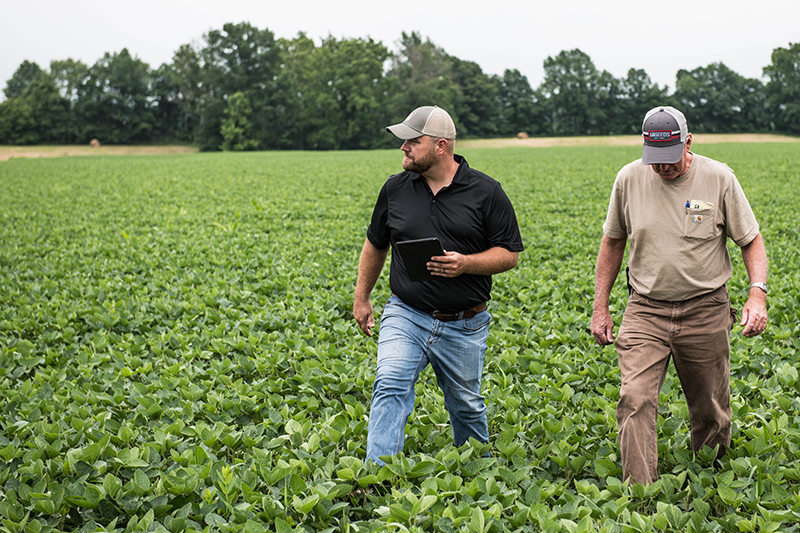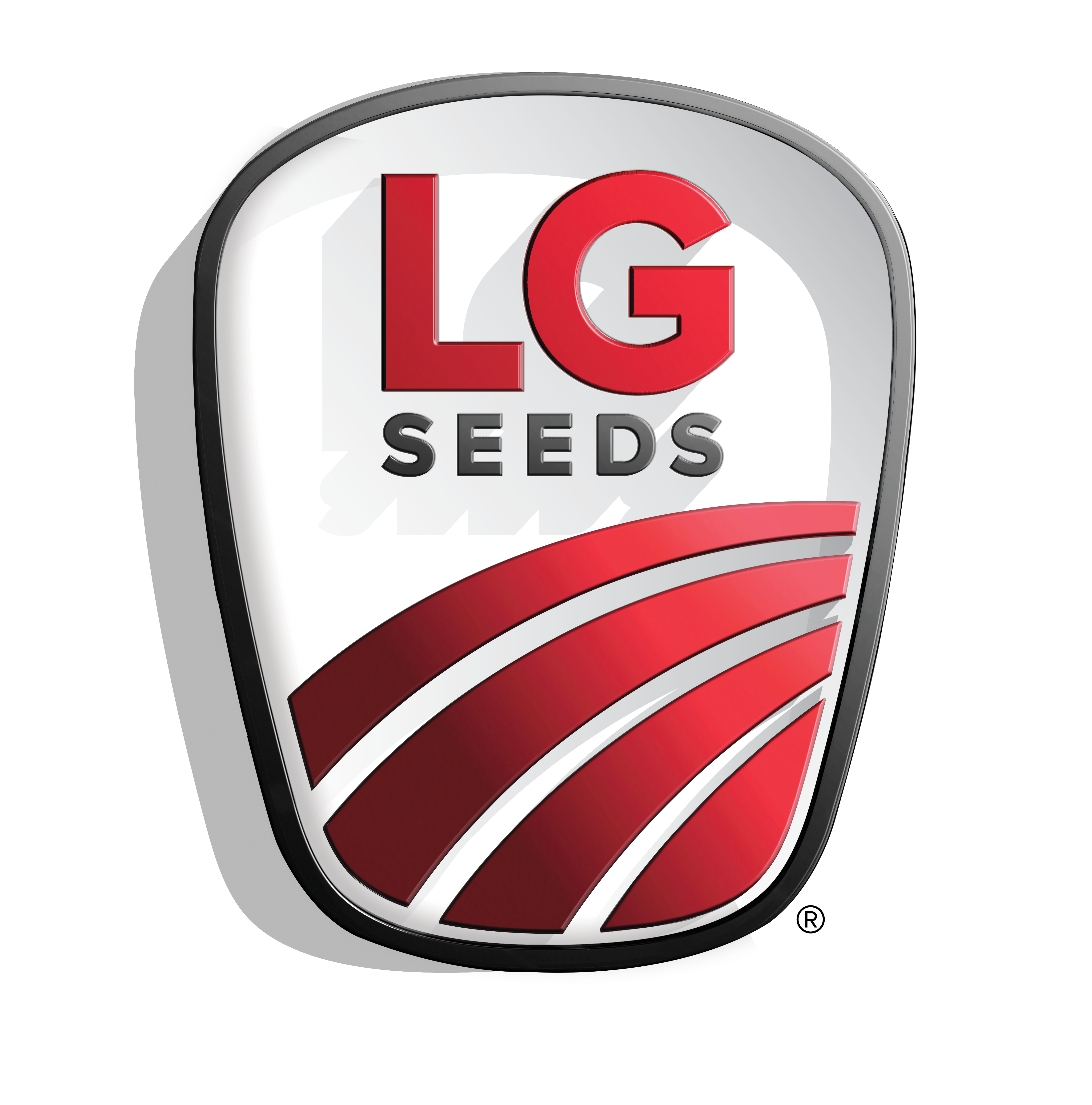AGRONOMICSUPPORT
YOU CAN TAKETO THE FIELD
28
Jun
2019
Early Season Soybean Pests | Bean Leaf Beetle
Early planted soybeans can make an attractive target for some soybean pests, particularly the Bean Leaf Beetle. Understanding the lifecycle and potential economic impact can help soybean growers make management decisions for this pest.
Identification and Life Cycle of the Bean Leaf Beetle

Identification and Life Cycle of the Bean Leaf Beetle
The bean leaf beetle (BLB) adult is approximately ¼ inch long and are generally yellow or reddish in color. They can either have 2 black spots on each wing cover or have no spots visible. The distinguishing mark that both variations have is a black triangle behind the thorax, or in layman’s terms the neck.
The BLB overwinter as adults in and around soybean fields, preferring leaf and plant litter in wooded areas. When spring temperatures reach 50-55° F, the adults begin to emerge and mate. They then return to weedy or brushy areas such as field margins, ditches, waterways, etc. Newly emerging soybeans are their preferred food source and they will move into soybeans fields feeding on stems, cotyledons, unifoliate and trifoliate leaves and begin to lay eggs. Eggs are generally laid in the top 2 inches of soil, close to plant stems. Eggs hatch in as little as 4 days but can take up to 14 days depending on temperatures. The larvae feed on plant roots and have 3 instars, however, root feeding is of little concern. The larvae will pupate approximately 23 days after hatching (warmer temperatures can reduce this time) and stay in the pupal stage for about 7 days. The newly hatched adults emerge and begin the process for the next generation, most of the Corn Belt experiences 2 generations per year. The second generation of BLB tend to feed on newly expanding trifoliate leaves, moving to the green tissue of pods once the leaves start to enlarge.
Economic Impact
Economic Impact
Heavy infestations of overwintering adults can lead to stand loss due to stem and cotyledon damage. Later generations feed on the leaves or pods, which may result in yield loss. The presence of 1st and 2nd generation BLB adults is noted by small round holes chewed in the leaves and/or pod damage or scarring. Scouting for BLB adults can be a challenge as the adults will drop to the ground when the plants are disturbed. Mid-morning or early evening are the best times to scout for adults. Prior to R1 (beginning bloom), the threshold for defoliation is 40%. Growth stages of R1 to R5 (beginning bloom to beginning seed) the defoliation threshold is 15% and after R6 (full seed) through harvest, the threshold for treatment is over 25% defoliation, 5% of pods show feeding and 10 or more adults are found per foot of row. BLB adults can also transmit Bean Pod Mottle Virus as they feed on soybean plants. Documented yield losses from early season infections have been as high as 16% in Nebraska. The presence of Bean Pod Mottle Virus is most widely identified by seed coat mottling often referred to as “bleeding hilum”, seeds may also have a reduced size. Foliar symptoms are green to yellow blotchiness of younger leaves, and severe infections may result in puckering in leaves and stunted plants.
Control
The use of a high-quality seed-applied insecticide is a great tool to use for controlling overwintering BLB adults. LG Seeds offers 3 different options for soybean growers use in BLB control. AgriShield® Plus combines fungicide and insecticide, AgriShield® Max combines fungicide, insecticide and inoculant and AgriSheld® Max with ILeVO® adds nematicide to the fungicide, insecticide and inoculant. The use of any of these three AgriShield® soybean seed treatments offers excellent control and convenience to
soybean growers dealing with populations of overwintering BLB that may also transmit Bean Pod Mottle Virus.
Later season (1st and 2nd generation) BLB activity that is above threshold levels can be kept in check with an application of a pyrethroid insecticide. Timing of the application can often coincide with soybean aphid activity or a fungicide application, allowing the grower to maximize the effectiveness of the insecticide application. If insecticide applications are necessary, contact your state Cooperative Extension Service or click here for control materials and rates suggested by Purdue University. Please follow label instructions.
Resources:
1. https://extension.entm.purdue.edu/fieldcropsipm/insects/bean-leaf-beetle.php
2. https://cropwatch.unl.edu/insect/beanleafbeetleid
3. https://crops.extension.iastate.edu/bean-leaf-beetle
Note: The information in this issue is based upon field observations and third-party information. Since variations in local conditions may affect
the information and suggestions contained in this issue, LG Seeds disclaims legal responsibility, therefore. Always read and follow label
instructions. LG Seeds and design are trademarks of AgReliant Genetic, Inc. Advantage Acre® is a registered trademark of AgReliant Genetics,
LLC. Advantage Acre is a product of AgReliant Genetics, LLC. AgriShield® is a registered trademark of AgReliant Genetics, LLC. ILeVO® is a
registered trademark of Bayer.
Control
The use of a high-quality seed-applied insecticide is a great tool to use for controlling overwintering BLB adults. LG Seeds offers 3 different options for soybean growers use in BLB control. AgriShield® Plus combines fungicide and insecticide, AgriShield® Max combines fungicide, insecticide and inoculant and AgriSheld® Max with ILeVO® adds nematicide to the fungicide, insecticide and inoculant. The use of any of these three AgriShield® soybean seed treatments offers excellent control and convenience to
soybean growers dealing with populations of overwintering BLB that may also transmit Bean Pod Mottle Virus.
Later season (1st and 2nd generation) BLB activity that is above threshold levels can be kept in check with an application of a pyrethroid insecticide. Timing of the application can often coincide with soybean aphid activity or a fungicide application, allowing the grower to maximize the effectiveness of the insecticide application. If insecticide applications are necessary, contact your state Cooperative Extension Service or click here for control materials and rates suggested by Purdue University. Please follow label instructions.
Resources:
1. https://extension.entm.purdue.edu/fieldcropsipm/insects/bean-leaf-beetle.php
2. https://cropwatch.unl.edu/insect/beanleafbeetleid
3. https://crops.extension.iastate.edu/bean-leaf-beetle
Note: The information in this issue is based upon field observations and third-party information. Since variations in local conditions may affect
the information and suggestions contained in this issue, LG Seeds disclaims legal responsibility, therefore. Always read and follow label
instructions. LG Seeds and design are trademarks of AgReliant Genetic, Inc. Advantage Acre® is a registered trademark of AgReliant Genetics,
LLC. Advantage Acre is a product of AgReliant Genetics, LLC. AgriShield® is a registered trademark of AgReliant Genetics, LLC. ILeVO® is a
registered trademark of Bayer.






Technical Team Agronomist